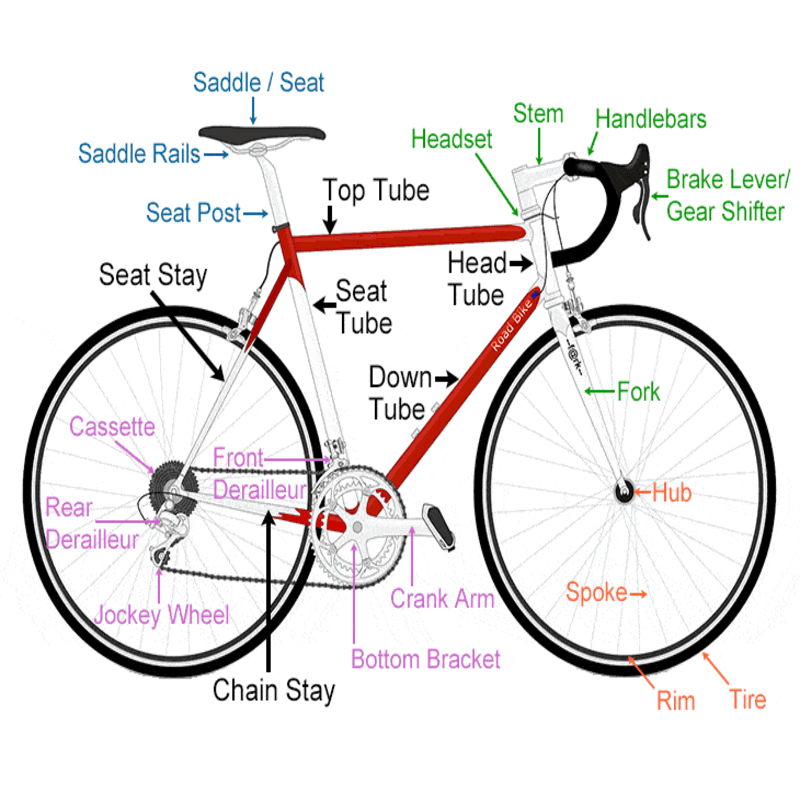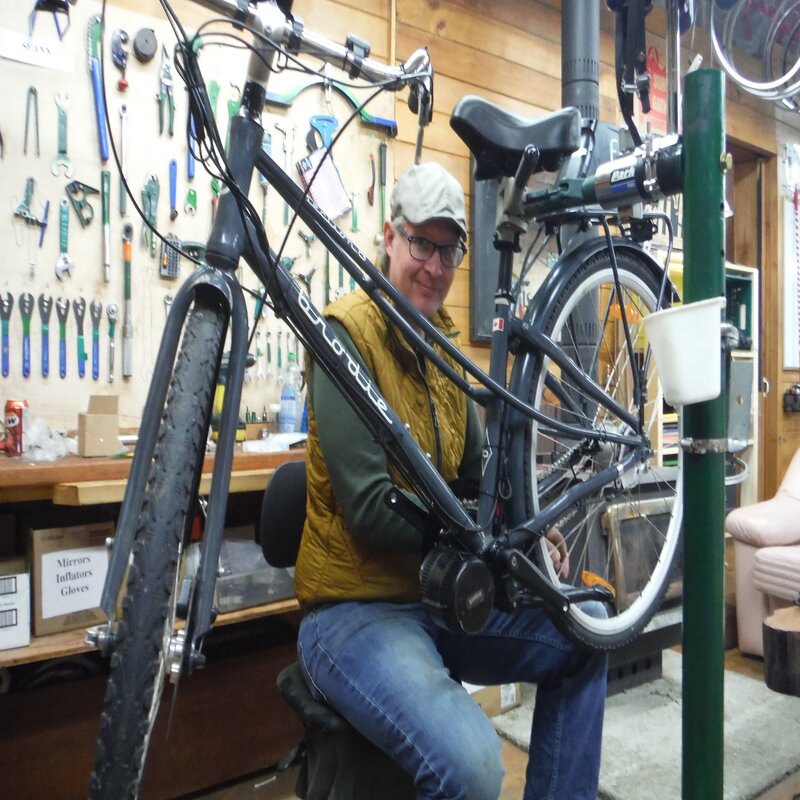Bicycles are complex machines composed of numerous parts that work together harmoniously to provide transportation, exercise, and joy. Understanding the various components of a bicycle is essential for maintenance, repair, and enhancing your riding experience. From the frame to the wheels, each part serves a specific function and contributes to the overall performance of the bicycle. This comprehensive guide explores the different parts of a bicycle, examining their functions and importance. By following these insights, you can better appreciate the intricacies of your bike and ensure it remains in excellent condition.
The Bicycle Frame
The frame is the backbone of a bicycle, providing structure and support. Therefore, exploring its different aspects is essential for understanding its role.
Frame Materials
Bicycle frames are made from various materials, each offering unique characteristics. The most common materials include steel, aluminum, carbon fiber, and titanium. Steel frames are known for their durability and comfort but are relatively heavy. Aluminum frames are lightweight, affordable, and resistant to corrosion, making them popular for recreational and competitive cycling. Carbon fiber frames offer exceptional strength-to-weight ratios and vibration damping, ideal for high-performance riding. Titanium frames combine lightweight properties and durability but come with a higher price tag. Therefore, understanding frame materials helps you choose a bike that meets your specific riding needs.
Frame Geometry
The geometry of a bicycle frame significantly impacts its handling, comfort, and performance. Key aspects of frame geometry include the head tube angle, seat tube angle, top tube length, and wheelbase. A steeper head tube angle results in quicker steering, while a slacker angle provides better stability. The seat tube angle affects rider positioning and pedaling efficiency. The length of the top tube determines the reach and overall fit of the bike. The wheelbase, the distance between the front and rear axles, influences stability and maneuverability. Therefore, recognizing the importance of frame geometry ensures you select a bike that offers the desired riding experience.

Wheels and Tires
Wheels and tires play a critical role in a bicycle’s performance, affecting speed, traction, and comfort. Therefore, exploring their components is crucial for understanding their functions.
Rims and Hubs
The rims and hubs are fundamental parts of bicycle wheels. The rim is the outer part of the wheel, providing support and shape for the tire. Rims are typically made from aluminum or carbon fiber and come in various sizes and profiles to suit different riding styles. The hub is the central part of the wheel that connects to the frame through the axle. Hubs house the bearings that enable the wheel to spin smoothly and may include features such as freewheels or freehubs for gear systems. Therefore, understanding rims and hubs helps ensure optimal wheel performance.
Tires and Tubes
Tires and tubes are essential for providing traction and shock absorption, contributing to a smooth and safe ride. Bicycle tires come in different types, including slick, semi-slick, knobby, and tubular, each suited to specific terrains and conditions. Slick tires offer low rolling resistance, ideal for road cycling. Knobby tires provide excellent traction on off-road trails. Tubes are inflatable rubber components placed inside the tire to hold air pressure. Some modern bicycles use tubeless tires, which eliminate the need for tubes and reduce the risk of flats. Therefore, recognizing the importance of tires and tubes ensures you select the right ones for your riding conditions.
Drivetrain Components
The drivetrain comprises components that transfer power from the rider to the wheels, enabling movement. Therefore, exploring drivetrain parts is essential for understanding their roles.
Crankset and Pedals
The crankset and pedals are crucial components of the drivetrain, enabling the rider to generate power. The crankset consists of one or more chainrings attached to the crank arms, which connect to the pedals. Cranksets vary in the number of chainrings, with single, double, and triple options available. Pedals are where the rider places their feet to pedal, and they come in different types, including flat, clipless, and platform pedals. Clipless pedals offer better power transfer and efficiency by securely attaching the foot to the pedal. Therefore, understanding the crankset and pedals helps enhance pedaling efficiency and performance.
Chain and Cassette
The chain and cassette are integral to the drivetrain, responsible for transferring power and enabling gear changes. The chain is a linked metal component that connects the crankset to the cassette on the rear wheel. Chains come in various widths and compatibility with specific gear systems, such as 9-speed, 10-speed, or 11-speed. The cassette consists of a series of sprockets that provide different gear ratios, allowing the rider to adjust their pedaling effort according to the terrain. The number of sprockets in a cassette can range from 5 to 12. Therefore, recognizing the importance of the chain and cassette ensures smooth and efficient gear changes.

Braking Systems
Braking systems are crucial for safety and control, allowing the rider to slow down or stop. Therefore, exploring different braking components is essential for understanding their functions.
Rim Brakes
Rim brakes are a common type of braking system, especially on road bikes and older bicycle models. These brakes work by applying pressure to the rims of the wheels using brake pads. Types of rim brakes include caliper brakes, cantilever brakes, and V-brakes. Caliper brakes are commonly found on road bikes, offering lightweight and efficient braking. Cantilever and V-brakes are often used on mountain bikes and offer more braking power and mud clearance. Therefore, understanding rim brakes helps ensure effective and responsive stopping power.
Disc Brakes
Disc brakes are increasingly popular due to their superior performance and reliability, especially in wet and muddy conditions. These brakes consist of a rotor attached to the wheel hub and calipers with brake pads that clamp onto the rotor. Disc brakes come in two types: mechanical (cable-actuated) and hydraulic. Hydraulic disc brakes offer better modulation and stopping power by using fluid to transfer force. Mechanical disc brakes are simpler and easier to maintain but may require more effort to achieve the same braking power. Therefore, recognizing the advantages of disc brakes ensures optimal braking performance in various conditions.
Steering and Control Components
Steering and control components determine how the rider interacts with and maneuvers the bicycle. Therefore, exploring these parts is crucial for understanding their roles.
Handlebars and Stem
Handlebars and stems are essential for controlling the bicycle and influencing rider comfort and handling. Flat and riser handlebars are common on mountain bikes, offering a more upright and comfortable riding position. Drop handlebars are standard on road bikes, providing multiple hand positions and an aerodynamic posture. The stem connects the handlebars to the steerer tube of the fork and comes in different lengths and angles to adjust reach and height. Therefore, understanding handlebars and stems ensures you find a setup that suits your riding style.
Headset and Fork
The headset and fork are crucial components for steering and absorbing shocks from the road or trail. The headset is a set of bearings that allows the fork to rotate smoothly within the head tube of the frame. Forks come in rigid and suspension types, each suited to different riding conditions. Rigid forks are lightweight and provide precise handling, ideal for road cycling. Suspension forks have built-in shock absorbers to absorb impacts and improve comfort, commonly used on mountain bikes. Therefore, recognizing the significance of the headset and fork ensures optimal steering and comfort.

Saddle and Seatpost
The saddle and seatpost are vital for rider support and comfort, influencing pedaling efficiency and posture. Therefore, exploring these components is essential for understanding their functions.
Saddle Types
Saddles come in various shapes, sizes, and materials to suit different riding styles and comfort preferences. Road saddles are typically narrow and lightweight, designed for efficiency and performance. Mountain bike saddles offer more padding and a wider shape for comfort on rough terrains. Touring saddles prioritize comfort for long-distance riding, featuring additional cushioning and ergonomic designs. Additionally, saddles come with features like cutouts and gel padding to reduce pressure and enhance comfort. Therefore, understanding saddle types helps you choose one that meets your comfort and riding requirements.
Seatpost Adjustments
The seatpost connects the saddle to the frame and allows for adjustments in height and angle. Seatposts come in different diameters and materials, including aluminum and carbon fiber. The height of the seatpost can be adjusted to achieve the optimal saddle height for efficient pedaling. Some seatposts also offer setback adjustments, allowing the saddle to be positioned forward or backward to fine-tune the rider’s posture. Dropper seatposts are a popular option for mountain biking, enabling the rider to lower or raise the saddle on the fly for varying terrain. Therefore, recognizing the significance of seatpost adjustments ensures a comfortable and efficient riding position.
Conclusion
Understanding the parts of a bicycle involves exploring various components such as the frame, wheels, drivetrain, brakes, steering, and saddle. Proper knowledge ensures optimal performance, comfort, and maintenance.
Exploring elements like frame materials and geometry, recognizing the importance of rims, hubs, and tires, and identifying drivetrain components provides valuable insights. Recognizing the significance of braking systems, steering components, and saddle adjustments further enriches your understanding.
By engaging with these aspects, you can appreciate the intricacies of your bicycle and ensure it remains in excellent condition. Therefore, whether you are a casual rider, a commuter, or an avid cyclist, understanding these parts offers practical and valuable insights. Embrace the opportunity to explore the components of your bicycle, knowing you have the knowledge and resources to maintain and enhance your riding experience!


